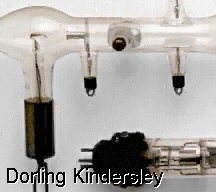
| |
 |
![]()
 From: How Things Work
From: How Things Work
By: Louis A. Bloomfield, Professor of Physics, The University of Virginia
Electric discharge lamps are between 2 and 5 times as energy efficient as normal incandescent light bulbs. The hot filament of an incandescent lamp delivers only about 10% of its electric power as visible light. In contrast, a florescent lamp delivers about 25% of its electric power as visible light and some gas discharge lamps (particularly low-pressure sodium vapor) deliver as much as 50% of their electric powers as visible light.
Q: How much life is consumed each time you turn on a fluorescent lamp?
The starting process erodes the electrodes of a fluorescent tube through a phenomenon called sputtering. A typical fluorescent tube will last about 50,000 hours if left on continuously but only 20,000 hours if it's turn on for just 3 hours at a time. From that tidbit, I think its fair to say that a fluorescent tube can only start about 10,000 times. If the tube costs $5, you are spending about 0.005 cents per start. If the electricity to operate that tube costs about 0.2 cents per hour, then turning the tube off for about 1.5 minutes saves the same amount of money in electricity as it costs in tube life when you turn the tube back on. In short, if you turn the lamp off for less than about 1 minute, you're wasting money. But if you turn it off for more than 10 minutes, you're saving money. In between, it's not so clear. There is a myth that turning on a fluorescent lamp consumes a huge amount of electricity so that you shouldn't turn the lamp off and on. There is simply no basis to that myth.
Q: What are the different types of light bulbs and how do they work?
An incandescent light bulb works by heating a solid filament so hot that the filament's thermal radiation spectrum includes large amounts of visible light. A fluorescent tube uses an electric discharge in mercury vapor to produce ultraviolet light, which is then transformed into visible light by fluorescent phosphors on the inner surface of the tube. A gas discharge lamp uses an electric discharge in a gas inside that lamp (often high pressure mercury, or sodium vapor, or even neon) to produce visible light directly.
Q: What is the composition of the phosphors used in fluorescent light bulbs?
The exact composition depends on the color type of the bulb, with the most common color types being cool white, warm white, deluxe cool white, and deluxe warm white. In each case, the phosphors are a mixture of crystals that may include: calcium halophosphate, calcium silicate, strontium magnesium phosphate, calcium strontium phosphate, and magnesium fluorogermanate. These crystals contain impurities that allow them to fluoresce visible light. These impurities include: antimony, manganese, tin, and lead.
Q: Do regular fluorescent lights emit ultraviolet light? If so, how does the ultraviolet level compare to what we would receive if we were outside?
While the electric discharge in the tube's mercury vapor emits large amounts of short wavelength ultraviolet light, virtually all of this ultraviolet light is absorbed by the tube's internal phosphor coating and glass envelope. As a result, a fluorescent lamp emits relatively little ultraviolet light. I think that the ultraviolet light level under fluorescent lighting is far less than that of outdoor sunlight.